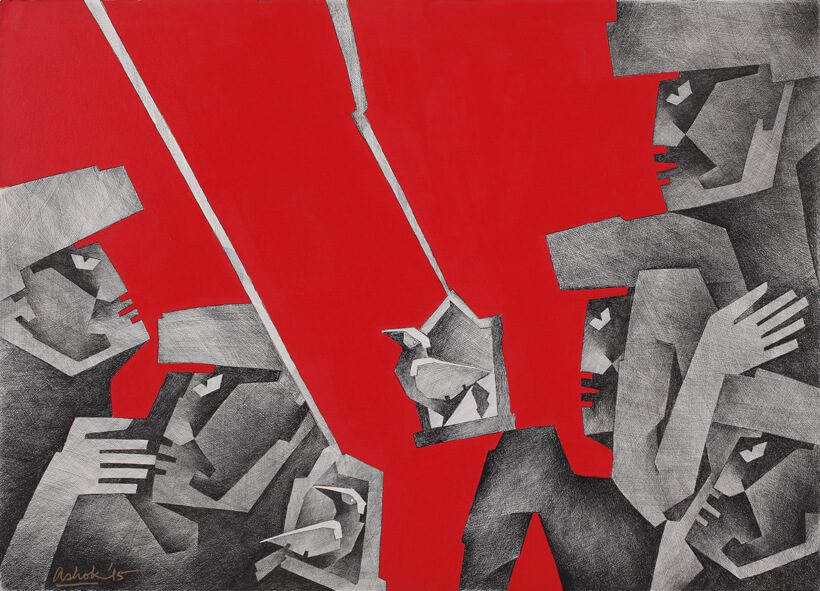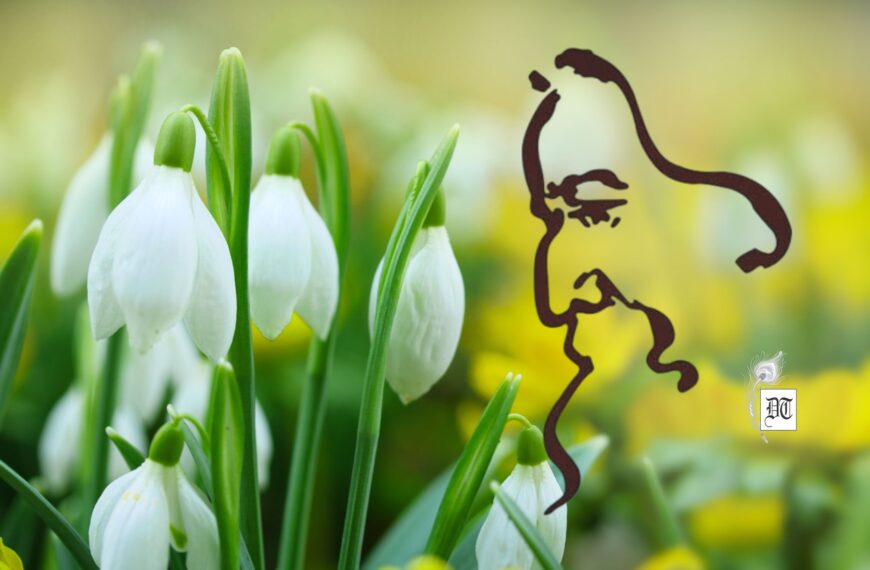Coal was used as a common fuel in homes and it also energised the steam engines. Ashok travels from lumps of coals to coal mines. He finds that the canary, sensitive to toxic gases in the coal mines, saved their lives. The relationship of canary and coal miners has many layers. It saddens the writer-artist, who tells us why he uses the birds in most of his paintings.

Just few decades back, coal used to be a common fuel in most of the Indian households. Most of us, who grew up in the sixties of the last century remember the sight and feel of hard, black stony coal and its use as fuel in our kitchens. Our association with coal was also bit ‘romantic’, as in our less frequent occasions to travel by trains; coal had its inseparable presence in railway yards and in the tenders of steam engines. Engines were the one of the wonder objects in our lives and we still remember the smell of thick, dark black fumes emanating out of the chimneys of the steam engines, majestic sound of its movements and above all, the call of its whistles.
Our association with coal grew stronger with the news of fatal accidents in the coal mines that reached us quite frequently. This was the time when we read Emily Zola’s Germinal, Richard Llewellyn’s How Green was my Valley and our very own Utpal Dutt’s play Angaar. We also heard about innumerable novels and stories on coal miners and coal mines written in various foreign languages.
That was how our association with coal, coal mines and coal miners grew. We came to know about a bird named Canary! It was 1974, when I had my first one-man show of my paintings at Kanpur. There were 21 works on display and among them a painting (oil on canvas) titled The bird Seller. It was one of my favorite. This painting incidentally received much accolades from the art lovers and criticsI am not sure if that was the reason for the birds to appear in my paintings after my first one man show. Years passed and ‘birds’ kept coming in my paintings almost effortlessly. Sometimes it also came metaphorically. During the eighties, when I was painting in only black and white, the birds came sometimes as ‘hatching the time clock’ or sometimes as a ‘blind bird watching moon at midnight’. In a painting it was seen ‘running away with a timepiece in its beak’. The birds of my paintings of this phase, reminded many critics of some pre-historic birds.
Later, in 1994-95 when I was painting in color, birds came more frequently as a companion of a girl. This was the time when I started my series ‘Amina and her bird’, where the bird was seen in a perennial conversation with a young lady named Amina. In my series ‘Dynasty’, the bird was seen perching on the ruins of an old palace and telling the stories of by gone days. In the paintings of my ‘Warli’ series, they are there with somewhat comical stance! In the series like ‘Street Children ‘, ‘Angels of the Street’ and ‘Jai Ho!’ they can be seen as a natural companions to the less privileged children.
Decades have passed since I exhibited first in 1974, I have travelled through different phases of my painting, changed my style and experimented with the forms but ‘birds’ were always in my painting . I know my birds like I know myself. My birds may resemble with some creature one may find in the nature, but they do not certainly represent any known bird. They are not the fauna that god created for this world; they are my ‘creations’.


Having said so much about the little creature called ‘bird’, I confess that for me the Canary became most romantic of all birds, from the day I came to know about its strange companionship with the miners. It pained me further when I found canary to be a singing bird. I tried to probe the relationship between the miners and the canary. Canary birds were in use for centuries to detect the presence of toxic gases inside the pit of the coal mines, as it has the rare capability to sense even the traces of the toxic gas. I could imagine the canaries dying inside the coal mines to warn the miners of the poisonous gases, thus saving the thousands human lives over the years. But, the fact remains that thousands of miners were killed in accidents and disasters in the coal mines due to inundation and fire. Our generation cannot forget the disasters of Chinakuri (1958), Dhori (1964) and Chasnala (1975) coal mines, where excessive greed of the coal mine owners coupled with the lack of empathy for the lives of the poor miners actually led to most of such accidents. Many a times, the sight of an insignificant chunk of coal by the side of a rail track, connected us with such coal mine tragedies and even without knowing those coal miners, we nurtured an intense sympathy for them.
I loved, adored and fancy this bird but could never create a space for it in my canvases, nor ever did I find any inner call to portray the coal miners till few years back!
During a casual chat with a young man (1983 born), our discussion engulfed the issue of coal as an important source of energy. I was shocked to find that while he had fair idea about the coal and its role in the power generation, he had never seen coal! I was even more astonished to find most of the young men of his generation did not know how a chunk of coal looked like! This fact disturbed me that those, who have not seen coal, are likely to be unaware of coal mining, the toils of coal miners, the coal mine disasters and many other things related to the lives of coal miners all over the world.
This incident triggered many things in my mind and I kept working on it for quite some time. Even after the practice of using canaries has long been abolished, we still find the canaries around, performing the same role, singing in the day and crying at night!
In this process, I could see the presence of canaries in the destinies of the slum dwellers, street children, high-risk factory labors and in the soldiers protecting the borders of his country. This also opened up before me the strange companionship in between coal miners and the canary. While coal miners were dependent on canaries for their lives, but canaries were not. How could a special ability of a creature be the cause of his death?


The very thought of uneasy fluttering of canary in presence of toxic gases disturbed me, and their death, which, in fact, was to save coal miners compelled me to take up this series. I visited few coal mines, including those around Ranigunj, in particular, and saw the lives of coal miners from a closer proximity. My paintings of this series, however, do not represent the faces and lives of coal miners I met during my visits to the coal mines and the coal miner’s settlements. Though one may not miss the presence of coal miners and canary in my paintings, they are not meant to represent a story. My series is all about coal, coal miners and the canary.
I have not intended to pass on a big message though my work, as I do not believe ‘art’ is capable of doing the same. I have also not ventured this series for my artistic pleasure alone. With all my sincerity and belief, I only wish that you connect with the coal miners and identify the hapless canaries around us.
Paintings by the artist





 By
By


 By
By